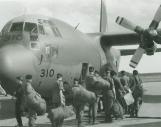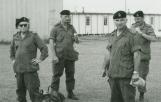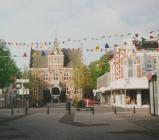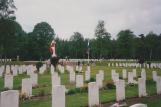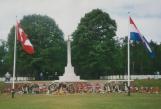1
07) Into the 21st Century 1991 - 2004- Veendam visit
- Cougars moved to Wainwright Alberta
- Small arms training
- BCD support Operation Peregrine
- Governor General's visit
3
Until the early 1990s the annual Milcon at Wainwright brought all the units of the Militia Area Pacific together for a week to train at the Brigade level. The BCDs would routinely join with the BC Regiment (DCO) from Vancouver, to form one regiment called the Pacific Armoured Regiment. The BCDs played the tank role and the BCRs played the Recce role. The Dragoons enjoyed the configuration because it provided them with the opportunity to train together as a distinct element. Commanding Officers of each unit alternated in the command of the joint regiment in the field.By 1993 however, the Land Force Western Area (LFWA), centered in Edmonton, Alberta, had come into existence and had performed a reorganization for the summer's Milcon, which now included units from Western Ontario through to the BC coast.
In 1996, several ceremonies were held throughout the valley. The Municipality of Peachland bestowed its 'Freedom of the City' on the regiment. LCol. Carl Stef commanded the parade that included Honorary Colonel Kinloch and the 15 Field Artillery Band. The Whizzbangs dedicated a monument to the founding of the regiment in Vernon on the occassion of the 50th anniversary of their 'homecoming' in 1946. Also a regimental parade was held in Westbank to present an official certificate of appreciation, signed by the District Commander, to the Chief of the Westbank First Nations. LCol. Stef presented a regimental pennant to Chief Eli in appreciation for the use of the land within Gallagher's Canyon, for exercises. In turn, Chief Eli presented an official band flag to the regiment.
5
Dutch citizens decorate their communities to mark the anniversary of their liberation.1995
Holten, Holland
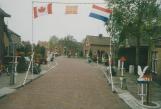
6
BCDs lead the anniversary parade through Loppersum to mark Holland's liberation.May, 1995
Loppersum, Holland
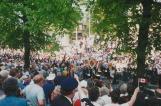
9
Col. Bernard J. Finestone and Cpl. Piercey laying a wreath on behalf of the Whizzbangs and the BCDsMay, 1995
Holten, Holland

11
Private Ralph Piercey of the Royal Highland Regiment (the Black Watch of Canada).May, 1995
Holten, Holland

12
Cpl. Piercey pays his respects to his uncle Pte. R. Piercey at the Holten Wra Cemetary.May, 1995
Holten, Holland

13
Cpl. Piercey places a poppy next to his uncle's grave at the Holten War Cemetary.May, 1995
Holten, Holland
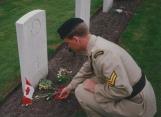
14
In 1998, the Village of Tavullia, Italy which was inside the Gothic Line in 1944, dedicated a monument to the Canadian soldiers who came to their country not to conquer it, but to liberate it instead. They erected it below 'Point 204' which was the objective taken and held by the unit during the Gothic Line battle. Invited to attend were veterans of the 1st Canadian Corps. 100 of them went including 25 from the BCD Whizzbangs Association. On 7 September 1998, Mayor Borra spoke stirringly, followed by Col. Kinloch who had fought there, then Art Eggleton, Canada's Minister of Defence, and his Italian counterpart .The regiment also sent LCol Jim Williamson and a delegation to the 'Trooping of the Colours' ceremony for the Royal Dragoon Guards (the 'Skins' after yet another unit amalgamation). Two serving members of the unit represented the BCDs on that parade. Master Corporal (Mcpl) Gayle Morris, was a rare sight because British women do not serve in Armoured units in the British Army.
Resources available to the regiment and the Reserves generally, took a turn for the worse during the 1990s as the Cold War ended with the fall of the Soviet Bloc, and Canada increased its military commitments elsewhere such as the Persian Gulf war then peacekeeping in the former Yugoslavia, amongst others. The closure of CFB Lahr, Germany and the end of Canada's role in Cyprus were more than compensated for by force reductions. The effect on the regiment was the loss of the AVGP Cougar, which was needed for convoy protection and patrol tasks in Bosnia. This meant that weekend tank training exercises could not be performed as before, and there were no further exercises in Yakima. Now the Dragoons had to fly to Wainwright to drive and shoot their main battle vehicle. It also meant that only those soldiers from the regiment serving in Bosnia with the UN and later the NATO missions, got to work with the Cougars.
